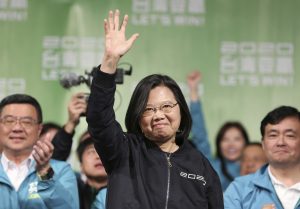On January 11, President Tsai Ing-wen’s re-election ended her rocky first term as Taiwan’s leader on a high note. Her landslide victory over Kuomintang (KMT) candidate Han Kuo-yu provided her with a clear mandate from the Taiwanese public: They want Tsai to continue to lead. Yet, in hindsight, Tsai’s popularity throughout her first three-plus years in office was never as high as it was the night of her re-election.
Tsai’s first term saw many highlights: same-sex marriage legislation finally passed, a formal apology was offered to indigenous Taiwanese on behalf of Taiwan’s government for the first time, and the New Southbound Policy (NSP) was mildly successful in reducing Taiwan’s economic reliance on China. However, Tsai had her share of fumbles, most visibly in her government’s handling of much-needed pension and labor reforms, as well as the passage of the same-sex marriage law, all of which contributed to low public approval ratings and culminated in easily the lowest point of her tenure: the disastrous 2018 local elections. Reflecting on her first term, there were many learning moments for Tsai, and, historically, her record has been mixed – even though her supporters’ hopes are high for a successful second term.
This article will first provide a comprehensive assessment of Tsai’s first term, broken down by issue, with particular emphasis on topics of concern in Taiwan domestic politics. It will then look forward, evaluating what her performance means for her second term, particularly with forthcoming leadership changes in her administration and more detailed policy plans to accompany the formal start of her second four years in office in May.
After an initial two-plus years of rocky reforms, Taiwan was not happy overall with Tsai’s performance. Her first midterm election was an unmitigated disaster. The 2018 midterm was effectively a de facto referendum on how Taiwanese voters viewed Tsai and the DPP’s progress. In mayoral races around Taiwan, the DPP lost seven out of 13 cities and counties. No one expected the KMT would win so many cities back after their own catastrophic loss in 2016. The most important of these races was Kaohsiung, a southern port city and historical DPP stronghold.
The DPP was defeated in the Kaohsiung mayoral race by Han Kuo-yu, whose momentous rise took Taiwan by storm. Although Han is now known as the KMT presidential candidate who lost to Tsai by a large margin, back in 2018 his meteoric rise gave everyone in Taiwan pause. Capitalizing on populist rhetoric and strong disillusionment with the DPP, Han managed to sway a deep green city into giving him, a candidate advocating closer ties to China, a chance at running their city. Han’s popularity snowballed, and over the next year he became the potential savior of the KMT. After the midterm, Tsai’s re-election odds appeared dim.

































